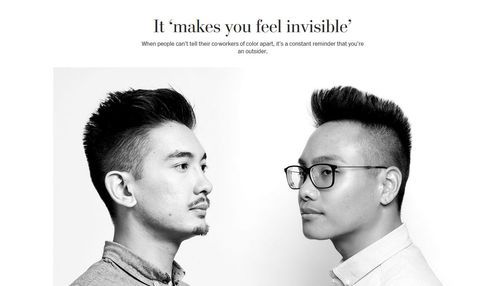More on the Current Year’s burning topic of “Let’s Talk About Me and My Looks. And My Feelings, You Vicious White Racist!” From the Washington Post today:
It ‘makes you feel invisible’
When people can’t tell their co-workers of color apart, it’s a constant reminder that you’re an outsider.
Jonathan Castanien, left, and Nicholas Pilapil were often mistaken for each other by their white co-workers.
Maybe try a less unfortunate haircut?
Basically, coworkers almost never notice changes in your facial hair, but they do notice and comment upon when you get a haircut. (I’ve worn glasses my whole life, but I suspect they don’t overtly notice switching from glasses to contacts much either.)
By Rachel Hatzipanagos
MAY 2, 2019It happened again. Nicholas Pilapil got an email clearly meant for his co-worker, Jonathan Castanien. Previously, Pilapil had missed a meeting invitation because their white co-workers couldn’t tell them apart.
Are we really sure their most forgetful co-workers are white? Or is it just safe to blame whites but not to blame nonwhites? Is there any evidence that blacks or Mexicans are better at and more sensitive to distinguishing Asians apart than are whites?
Pilapil called Castanien his “work twin” — sarcastically, because they bear only a passing resemblance to each other. Aside from being in their 20s, they don’t share many characteristics: Pilapil is Filipino, has fuller lips, a squarer jaw and a darker complexion than Castanien, who is Vietnamese, Chinese and German.
While their cubicles were next to each other, Pilapil worked in communications and Castanien worked in public relations.
You have to be pretty darn racist not to immediately grasp the profound differences between working in Communications versus working in Public Relations!
The only thing that could have prompted their colleagues’ confusion, Pilapil says, was that they both had Asian heritage.
That and the quasi-Mohawk haircuts. And being the same height. And about the same age.
Pilapil and Castanien’s experience is common. When About Us asked people of color on Twitter for stories about being misidentified in predominantly white places, more than 400 people replied, including a digital marketing consultant whose client kept calling him by his gardener’s name and a professor whose student turned in a paper with the wrong professor’s name.
The implication is that, while white people are seen as individuals, other groups are often viewed as a monolith, with their race or ethnicity becoming the defining characteristic of who they are.
“If we just identify someone as a ‘black person,’ then that is how we are going to see them,” said Kareem Johnson, an associate professor of psychology at Temple University.
While many on the receiving end of this phenomenon say it’s another example of every day racism, it does not necessarily indicate negative racial attitudes, Johnson said. Rather, it’s part of a larger cognitive problem called the cross-race effect — essentially, the impression that people of a race other than your own “all look the same.”
“We have much more difficulty recognizing people of a different racial group than we do our own,” he said.
But the racial demographics of the United States make that far less likely, given 65 percent of U.S. workers are white. And white people are far more visible in U.S. media, making all Americans more attuned to their physical differences.
The only solution is:
A. Import vastly more people of other races so whites aren’t a majority anymore.
B. Put nonwhite media personalities, like the PoCemon Points-laden authors of all these Let’s Talk About Me articles, on TV much more often.
[Comment at Unz.com]While #RepresentationMatters has become a cultural force in demanding visibility for people of color in film and television in recent years, generations of Americans have grown up watching mostly white faces on screen and in speaking roles where they are given more depth and humanity.
“As a minority in America, you’re much more likely to get practice differentiating between white faces due to more exposure,” Johnson said.
While there are cognitive explanations for the “work twin” problem, these kinds of common, subtle slights, known as microaggressions, cause undue stress over time. Microaggressions — such as asking Asian Americans where they’re from or repeatedly mispronouncing a person’s name — make people of color permanent outsiders and create constant discomfort in offices, schools and other places where they have to be.














